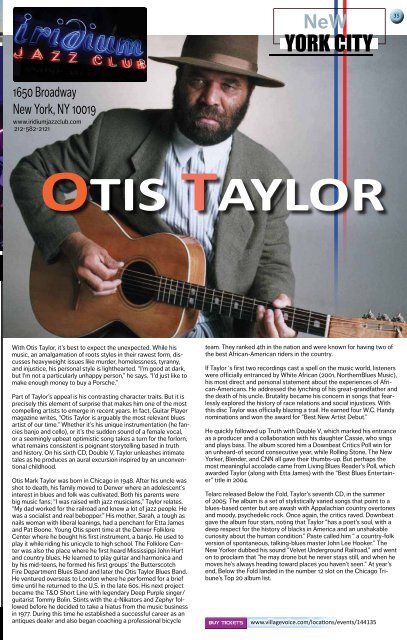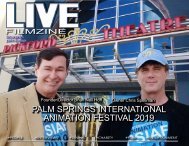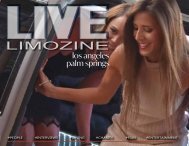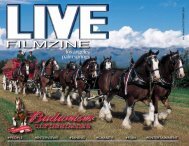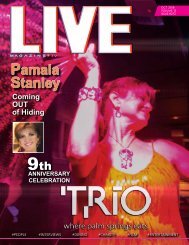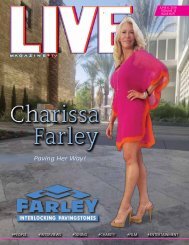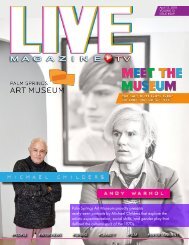Create successful ePaper yourself
Turn your PDF publications into a flip-book with our unique Google optimized e-Paper software.
NeW<br />
YORK CITY<br />
35<br />
35<br />
1650 Broadway<br />
New York, NY 10019<br />
www.iridiumjazzclub.com<br />
212-582-2121<br />
OTIS TAYLOR<br />
With Otis Taylor, it’s best to expect the unexpected. While his<br />
music, an amalgamation of roots styles in their rawest form, discusses<br />
heavyweight issues like murder, homelessness, tyranny,<br />
and injustice, his personal style is lighthearted. “I’m good at dark,<br />
but I’m not a particularly unhappy person,” he says. “I’d just like to<br />
make enough money to buy a Porsche.”<br />
Part of Taylor’s appeal is his contrasting character traits. But it is<br />
precisely this element of surprise that makes him one of the most<br />
compelling artists to emerge in recent years. In fact, Guitar Player<br />
magazine writes, “Otis Taylor is arguably the most relevant blues<br />
artist of our time.” Whether it’s his unique instrumentation (he fancies<br />
banjo and cello), or it’s the sudden sound of a female vocal,<br />
or a seemingly upbeat optimistic song takes a turn for the forlorn,<br />
what remains consistent is poignant storytelling based in truth<br />
and history. On his sixth CD, Double V, Taylor unleashes intimate<br />
tales as he produces an aural excursion inspired by an unconventional<br />
childhood.<br />
Otis Mark Taylor was born in Chicago in 1948. After his uncle was<br />
shot to death, his family moved to Denver where an adolescent’s<br />
interest in blues and folk was cultivated. Both his parents were<br />
big music fans; “I was raised with jazz musicians,” Taylor relates.<br />
“My dad worked for the railroad and knew a lot of jazz people. He<br />
was a socialist and real bebopper.” His mother, Sarah, a tough as<br />
nails woman with liberal leanings, had a penchant for Etta James<br />
and Pat Boone. Young Otis spent time at the Denver Folklore<br />
Center where he bought his first instrument, a banjo. He used to<br />
play it while riding his unicycle to high school. The Folklore Center<br />
was also the place where he first heard Mississippi John Hurt<br />
and country blues. He learned to play guitar and harmonica and<br />
by his mid-teens, he formed his first groups’ the Butterscotch<br />
Fire Department Blues Band and later the Otis Taylor Blues Band.<br />
He ventured overseas to London where he performed for a brief<br />
time until he returned to the U.S. in the late 60s. His next project<br />
became the T&O Short Line with legendary Deep Purple singer/<br />
guitarist Tommy Bolin. Stints with the 4-Nikators and Zephyr followed<br />
before he decided to take a hiatus from the music business<br />
in 1977. During this time he established a successful career as an<br />
antiques dealer and also began coaching a professional bicycle<br />
team. They ranked 4th in the nation and were known for having two of<br />
the best African-American riders in the country.<br />
If Taylor ‘s first two recordings cast a spell on the music world, listeners<br />
were officially entranced by White African (2001, NorthernBlues Music),<br />
his most direct and personal statement about the experiences of African-Americans.<br />
He addressed the lynching of his great-grandfather and<br />
the death of his uncle. Brutality became his concern in songs that fearlessly<br />
explored the history of race relations and social injustices. With<br />
this disc Taylor was officially blazing a trail. He earned four W.C. Handy<br />
nominations and won the award for “Best New Artist Debut.”<br />
He quickly followed up Truth with Double V, which marked his entrance<br />
as a producer and a collaboration with his daughter Cassie, who sings<br />
and plays bass. The album scored him a Downbeat Critics Poll win for<br />
an unheard-of second consecutive year, while Rolling Stone, The New<br />
Yorker, Blender, and CNN all gave their thumbs-up. But perhaps the<br />
most meaningful accolade came from Living Blues Reader’s Poll, which<br />
awarded Taylor (along with Etta James) with the “Best Blues Entertainer”<br />
title in 2004.<br />
Telarc released Below the Fold, Taylor’s seventh CD, in the summer<br />
of 2005. The album is a set of stylistically varied songs that point to a<br />
blues-based center but are awash with Appalachian country overtones<br />
and moody, psychedelic rock. Once again, the critics raved. Downbeat<br />
gave the album four stars, noting that Taylor “has a poet’s soul, with a<br />
deep respect for the history of blacks in America and an unshakable<br />
curiosity about the human condition.” Paste called him “ a country-folk<br />
version of spontaneous, talking-blues master John Lee Hooker.” The<br />
New Yorker dubbed his sound “Velvet Underground Railroad,” and went<br />
on to proclaim that “he may drone but he never stays still, and when he<br />
moves he’s always heading toward places you haven’t seen.” At year’s<br />
end, Below the Fold landed in the number 12 slot on the Chicago Tribune’s<br />
Top 20 album list.<br />
www.villagevoice.com/locations/events/144135


